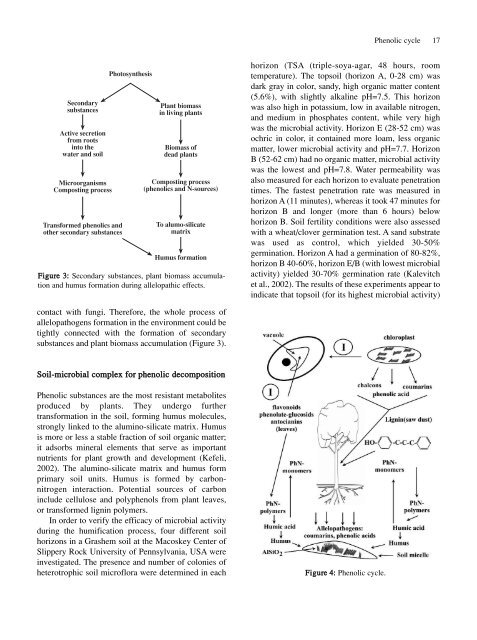(Converted)-4 - Journal of Cell and Molecular Biology - Haliç ...
(Converted)-4 - Journal of Cell and Molecular Biology - Haliç ...
(Converted)-4 - Journal of Cell and Molecular Biology - Haliç ...
Create successful ePaper yourself
Turn your PDF publications into a flip-book with our unique Google optimized e-Paper software.
Secondary<br />
substances<br />
Active secretion<br />
from roots<br />
into the<br />
water <strong>and</strong> soil<br />
Microorganisms<br />
Composting process<br />
Transformed phenolics <strong>and</strong><br />
other secondary substances<br />
Photosynthesis<br />
Plant biomass<br />
in living plants<br />
Biomass <strong>of</strong><br />
dead plants<br />
Composting process<br />
(phenolics <strong>and</strong> N-sources)<br />
To alumo-silicate<br />
matrix<br />
Humus formation<br />
Figure 3: Secondary substances, plant biomass accumulation<br />
<strong>and</strong> humus formation during allelopathic effects.<br />
contact with fungi. Therefore, the whole process <strong>of</strong><br />
allelopathogens formation in the environment could be<br />
tightly connected with the formation <strong>of</strong> secondary<br />
substances <strong>and</strong> plant biomass accumulation (Figure 3).<br />
Soil-microbial complex for phenolic decomposition<br />
Phenolic substances are the most resistant metabolites<br />
produced by plants. They undergo further<br />
transformation in the soil, forming humus molecules,<br />
strongly linked to the alumino-silicate matrix. Humus<br />
is more or less a stable fraction <strong>of</strong> soil organic matter;<br />
it adsorbs mineral elements that serve as important<br />
nutrients for plant growth <strong>and</strong> development (Kefeli,<br />
2002). The alumino-silicate matrix <strong>and</strong> humus form<br />
primary soil units. Humus is formed by carbonnitrogen<br />
interaction. Potential sources <strong>of</strong> carbon<br />
include cellulose <strong>and</strong> polyphenols from plant leaves,<br />
or transformed lignin polymers.<br />
In order to verify the efficacy <strong>of</strong> microbial activity<br />
during the humification process, four different soil<br />
horizons in a Grashem soil at the Macoskey Center <strong>of</strong><br />
Slippery Rock University <strong>of</strong> Pennsylvania, USA were<br />
investigated. The presence <strong>and</strong> number <strong>of</strong> colonies <strong>of</strong><br />
heterotrophic soil micr<strong>of</strong>lora were determined in each<br />
Phenolic cycle 17<br />
horizon (TSA (triple-soya-agar, 48 hours, room<br />
temperature). The topsoil (horizon A, 0-28 cm) was<br />
dark gray in color, s<strong>and</strong>y, high organic matter content<br />
(5.6%), with slightly alkaline pH=7.5. This horizon<br />
was also high in potassium, low in available nitrogen,<br />
<strong>and</strong> medium in phosphates content, while very high<br />
was the microbial activity. Horizon E (28-52 cm) was<br />
ochric in color, it contained more loam, less organic<br />
matter, lower microbial activity <strong>and</strong> pH=7.7. Horizon<br />
B (52-62 cm) had no organic matter, microbial activity<br />
was the lowest <strong>and</strong> pH=7.8. Water permeability was<br />
also measured for each horizon to evaluate penetration<br />
times. The fastest penetration rate was measured in<br />
horizon A (11 minutes), whereas it took 47 minutes for<br />
horizon B <strong>and</strong> longer (more than 6 hours) below<br />
horizon B. Soil fertility conditions were also assessed<br />
with a wheat/clover germination test. A s<strong>and</strong> substrate<br />
was used as control, which yielded 30-50%<br />
germination. Horizon A had a germination <strong>of</strong> 80-82%,<br />
horizon B 40-60%, horizon E/B (with lowest microbial<br />
activity) yielded 30-70% germination rate (Kalevitch<br />
et al., 2002). The results <strong>of</strong> these experiments appear to<br />
indicate that topsoil (for its highest microbial activity)<br />
Figure 4: Phenolic cycle.
















